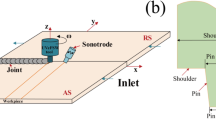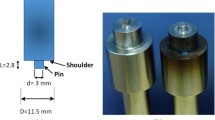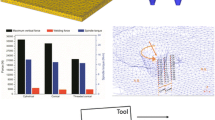Abstract
Friction stir welding (FSW) tool pin, as a critical component of FSW tool, plays an important role in determining the final joint properties by affecting the heat generation, plastic material flow, welding loads, and so on. However, the effects of tool pin on heat and mass transfer in FSW are not elucidated and quantitative studied. In the present study, a validated model was adopted to quantitatively analyze the effects of pin size and taper angle on the thermal process and plastic material flow in FSW. The effects of pin root diameter, pin tip diameter, and pin taper angle on heat and mass transfer in FSW were quantitatively investigated, respectively. It reveals that the torque and transverse force imposed on the pin are increased with the increase of the pin diameters (including its root diameter, its tip diameter, and its size in condition of constant taper angle), while the total tool torque varies a little for the tool pin diameter considered in this study. When the pin diameters increase, the viscosity of the materials near the pin is decreased, while the temperature as well as the flow velocity is increased. More plastic material near the tool could rotate around the tool with an increase of the pin diameter. The TMAZ boundary is enlarged with larger pin diameters in FSW. Particularly, the shear layer thickness of the same horizontal plane in the range of 1 mm < z < 5 mm is significantly enlarged with an increase of pin root diameters. However, the shear layer thickness of the same horizontal plane in the region of z < 5 mm is increased when using a larger pin tip diameter. In addition, maximum width of TMAZ boundary at the top surface of workpiece was not affected by pin diameters. The model is validated by experimental results. It could lay a solid foundation for optimizing the tool pin size and taper angle in FSW.



















Similar content being viewed by others
References
He X, Gu F, Ball A (2014) A review of numerical analysis of friction stir welding. Prog Mater Sci 65:1–66
Threadgill PL, Leonard AJ, Shercliff HR, Withers PJ (2009) Friction stir welding of aluminium alloys. Int Mater Rev 54(2):49–93
Chen K, Liu X, Ni J (2019) A review of friction stir-based processes for joining dissimilar materials. Int J Adv Manuf Technol 104:1709–1731
Nandan R, Debroy T, Bhadeshia H (2008) Recent advances in friction-stir welding-process, weldment structure and properties. Prog Mater Sci 53(6):980–1023
Mugada KK, Adepu K (2018) Influence of tool shoulder end features on friction stir weld characteristics of Al-Mg-Si alloy. Int J Adv Manuf Technol 88:1553–1566
Rai R, De A, Bhadeshia HKDH, DebRoy T (2011) Review: friction stir welding tools. Sci Technol Weld Join 16(4):325–342
Mirzaei M, Asadi P, Fazli A (2020) Effect of tool pin profile on material flow in double shoulder friction stir welding of AZ91 magnesium alloy. Int J Mech Sci 183:105775
Suresha CN, Rajaprakash BM, Upadhya S (2011) A study of the effect of tool pin profiles on tensile strength of welded joints produced using friction stir welding process. Mater Manuf Process 26(9):1111–1116
Quintana KJ, Silveira JLL (2017) Mechanistic models and experimental analysis for the torque in FSW considering the tool geometry and the process velocities. J Manuf Process 30:406–417
Elangovan K, Balasubramanian V (2008) Influences of tool pin profile and tool shoulder diameter on the formation of friction stir processing zone in AA6061 aluminium alloy. Mater Design 29(2):362–373
Marzbanrad J, Akbari M, Asadi P, Safaee S (2014) Characterization of the influence of tool pin profile on microstructural and mechanical properties of friction stir welding. Metall Mater Trans B Process Metall Mater Process Sci 45(5):1887–1894
Prakash P, Anand RS, Jha SK (2020) Prediction of weld zone shape with effect of tool pin profile in friction stir welding process. J Mech Sci Technol 34(1):279–287
Su H, Wu CS, Bachmann M, Rethmeier M (2015) Numerical modeling for the effect of pin profiles on thermal and material flow characteristics in friction stir welding. Mater Design 77:114–125
Akbari M, Aliha M, Keshavarz S, Bonyadi A (2019) Effect of tool parameters on mechanical properties, temperature, and force generation during FSW. Proc Inst Mech Eng, Part L 233(6):1033–1043
Kulekci MK, Şik A, Kaluç E (2008) Effects of tool rotation and pin diameter on fatigue properties of friction stir welded lap joints. Int J Adv Manuf Technol 36(9-10):877–882
Ramachandran KK, Murugan N, Shashi Kumar S (2015) Effect of tool axis offset and geometry of tool pin profile on the characteristics of friction stir welded dissimilar joints of aluminum alloy AA5052 and HSLA steel. Mater Sci Eng A 639:219–233
Zhang Z, Wu Q, Zhang H (2014) Numerical studies of effect of tool sizes and pin shapes on friction stir welding of AA2024-T3 alloy. T Nonferr Metal Soc 24(10):3293–3301
Buffa G, Hua J, Shivpuri R, Fratini L (2006) Design of the friction stir welding tool using the continuum based FEM model. Mater Sci Eng A 419(1-2):381–388
Nandan R, Roy GG, Lienert TJ, DebRoy T (2006) Numerical modelling of 3D plastic flow and heat transfer during friction stir welding of stainless steel. Sci Technol Weld Join 11(5):526–537
Chen G, Shi Q, Li Y, Sun Y, Dai Q, Jia J, Zhu Y, Wu J (2013) Computational fluid dynamics studies on heat generation during friction stir welding of aluminum alloy. Comput Mater Sci 79:540–546
Shi L, Wu CS, Liu HJ (2015) The effect of the welding parameters and tool size on the thermal process and tool torque in reverse dual-rotation friction stir welding. Int J Mach Tools Manuf 91:1–11
Colegrove PA, Shercliff HR (2005) 3-Dimensional CFD modelling of flow round a threaded friction stir welding tool profile. J Mater Process Technol 169(2):320–327
Sheppard T, Jackson A (1997) Constitutive equations for use in prediction of flow stress during extrusion of aluminium alloys. Mater Sci Technol 13(3):203–209
Arora A, De A, DebRoy T (2011) Toward optimum friction stir welding tool shoulder diameter. Scr Mater 64(1):9–12
Schmidt H, Hattel J, Wert J (2004) An analytical model for the heat generation in friction stir welding. Model Simul Mater Sci Eng 12(1):143–157
Chen G, Zhang S, Zhu Y, Yang C, Shi Q (2020) Thermo-mechanical analysis of friction stir welding: a review on recent advances. Acta Metall Sin 33(1):3–12
Mehta M, Chatterjee K, De A (2013) Monitoring torque and traverse force in friction stir welding from input electrical signatures of driving motors. Sci Technol Weld Join 18(3):191–197
Arora A, Mehta M, De A, DebRoy T (2012) Load bearing capacity of tool pin during friction stir welding. Int J Adv Manuf Technol 61(9-12):911–920
Ulysse P (2002) Three-dimensional modeling of the friction stir-welding process. Int J Mach Tool Manu 42(14):1549–1557
Bastier A, Maitournam MH, Dang Van K, Roger F (2006) Steady state thermomechanical modelling of friction stir welding. Sci Technol Weld Join 11(3):278-288
Shi L, Wu CS, Fu L (2020) Effects of tool shoulder size on the thermal process and material flow behaviors in ultrasonic vibration enhanced friction stir welding. J Manuf Process 53:69–83
Su H, Wu C (2019) Determination of the traverse force in friction stir welding with different tool pin profiles. Sci Technol Weld Join 24(3):209–217
Zeng XH, Xue P, Wang D, Ni DR, Xiao BL, Ma ZY (2018) Effect of processing parameters on plastic flow and defect formation in friction-stir-welded aluminum alloy. Metall Mater Trans A 49(7):2673–2683
Carlone P, Palazzo GS (2013) Influence of process parameters on microstructure and mechanical properties in AA2024-T3 friction stir welding. Metallogr Microstruct Anal 2(4):213–222
Funding
This work is supported by the National Natural Science Foundation of China (Grant Nos. 51905309 and 52035005) and Qilu Young Scholar Program of Shandong University.
Author information
Authors and Affiliations
Contributions
Jie Chen: Conceptualization, formal analysis, investigation, and writing-original draft. Lei Shi: Methodology, supervision, project administration, funding acquisition, and writing-review and editing. Chuansong Wu: Funding acquisition, project administration, and validation. Yuanning Jiang: Investigation and validation.
Corresponding author
Ethics declarations
Ethics approval and consent to participate
No applicable.
Consent for publication
Authors consent to publish this article.
Competing interests
The authors declare no competing interests.
Additional information
Publisher’s note
Springer Nature remains neutral with regard to jurisdictional claims in published maps and institutional affiliations.
Rights and permissions
About this article
Cite this article
Chen, J., Shi, L., Wu, C. et al. The effect of tool pin size and taper angle on the thermal process and plastic material flow in friction stir welding. Int J Adv Manuf Technol 116, 2847–2860 (2021). https://doi.org/10.1007/s00170-021-07650-x
Received:
Accepted:
Published:
Issue Date:
DOI: https://doi.org/10.1007/s00170-021-07650-x




